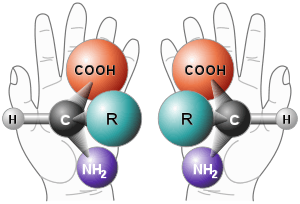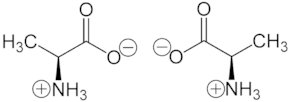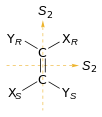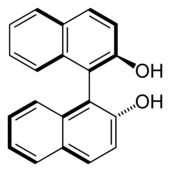Chirality (chemistry)
In chemistry, a molecule or ion is called chiral (/kaɪˈræl/) if it cannot be superposed on its mirror image by any combination of rotations and translations. This geometric property is called chirality.[1][2][3][4] The terms are derived from Ancient Greek χείρ (cheir), meaning "hand"; which is the canonical example of an object with this property.


A chiral molecule or ion exists in two stereoisomers that are mirror images of each other, called enantiomers; they are often distinguished as either "right-handed" or "left-handed" by their absolute configuration or some other criterion. The two enantiomers have the same chemical properties, except when reacting with other chiral compounds. They also have the same physical properties, except that they often have opposite optical activities. A homogeneous mixture of the two enantiomers in equal parts is said to be racemic, and it usually differs chemically and physically from the pure enantiomers.
A chiral molecule or ion must have at least one chiral center or stereocenter. When that center coincides with an atom, the substance is said to have point chirality. In chiral organic compounds, a stereocenter is often an asymmetric carbon. Multiple stereocenters may give rise to additional stereoisomers. On the other hand, a molecule with an even number of stereocenters may have one or more stereoisomers which are not chiral.
Chirality is an important concept for stereochemistry and biochemistry. Most substances relevant to biology are chiral, such as carbohydrates (sugars, starch, and cellulose), the amino acids that are the building blocks of proteins, and the nucleic acids. In living organisms, one typically finds only one of the two enantiomers or a chiral compound. For that reason, organisms that consume a chiral compound usually can metabolize only one of its enantiomers. For the same reason, the two enantiomers of a chiral pharmaceutical usually have vastly different potencies and/or effects.
Definition
Chirality is based on molecular symmetry. Specifically, a chiral compound can contain no improper axis of rotation (Sn), which includes planes of symmetry and inversion center. Chiral molecules are always dissymmetric (lacking Sn) but not always asymmetric (lacking all symmetry elements except the trivial identity). Asymmetric molecules are always chiral.[5]
| Rotational axis (Cn) | Improper rotational elements (Sn) | ||
|---|---|---|---|
| Chiral no Sn | Achiral mirror plane S1 = σ | Achiral inversion centre S2 = i | |
| C1 |  |  |  |
| C2 |  |  |  |
Stereogenic centers
Many chiral molecules have point chirality, namely a single stereogenic center that coincides with an atom. This stereogenic center usually has four or more bonds to different groups, and may be carbon (as in many biological molecules), silicon, or a metal (as in many chiral coordination compounds). However, a stereogenic center can also be a trivalent atom whose bonds are not in the same plane, such as phosphorus in P-chiral phosphines (PRR′R″) and sulfur in S-chiral sulfoxides (OSRR′).
Chirality can also arise from isotopic differences between atoms, such as in the deuterated benzyl alcohol PhCHDOH; which is chiral and optically active ([α]D = 0.715°), even though the non-deuterated compound PhCH2OH is not.[6]
If two enantiomers easily interconvert, the pure enantiomers may be practically impossible to separate, and only the racemic mixture is observable. This is the case, for example, of most amines with three different substituents (NRR′R″), because of the low energy barrier for nitrogen inversion.

While the presence of a stereogenic center describes the great majority of chiral molecules, many variations and exceptions exist. For instance it is not necessary for the chiral substance to have a stereogenic center. Examples include 1-bromo-3-chloro-5-fluoroadamantane, methylethylphenyltetrahedrane, certain calixarenes and fullerenes, which have inherent chirality. The C2-symmetric species 1,1′-bi-2-naphthol (BINOL), 1,3-dichloroallene have axial chirality. (E)-cyclooctene and many ferrocenes have planar chirality.
When the optical rotation for an enantiomer is too low for practical measurement, the species is said to exhibit cryptochirality.
Manifestations of chirality
- Flavour: the artificial sweetener aspartame has two enantiomers. L-aspartame tastes sweet whereas D-aspartame is tasteless.[7]
- Odor: R-(–)-carvone smells like spearmint whereas S-(+)-carvone smells like caraway.[8]
- Drug effectiveness: the antidepressant drug Citalopram is sold as a racemic mixture. However, studies have shown that only the (S)-(+) enantiomer is responsible for the drug's beneficial effects.[9][10]
- Drug safety: D‑penicillamine is used in chelation therapy and for the treatment of rheumatoid arthritis whereas L‑penicillamine is toxic as it inhibits the action of pyridoxine, an essential B vitamin.[11]
In biochemistry
Many biologically active molecules are chiral, including the naturally occurring amino acids (the building blocks of proteins) and sugars.
The origin of this homochirality in biology is the subject of much debate.[12] Most scientists believe that Earth life's "choice" of chirality was purely random, and that if carbon-based life forms exist elsewhere in the universe, their chemistry could theoretically have opposite chirality. However, there is some suggestion that early amino acids could have formed in comet dust. In this case, circularly polarised radiation (which makes up 17% of stellar radiation) could have caused the selective destruction of one chirality of amino acids, leading to a selection bias which ultimately resulted in all life on Earth being homochiral.[13][14]
Enzymes, which are chiral, often distinguish between the two enantiomers of a chiral substrate. One could imagine an enzyme as having a glove-like cavity that binds a substrate. If this glove is right-handed, then one enantiomer will fit inside and be bound, whereas the other enantiomer will have a poor fit and is unlikely to bind.
L-forms of amino acids tend to be tasteless, whereas D-forms tend to taste sweet.[12] Spearmint leaves contain the L-enantiomer of the chemical carvone or R-(−)-carvone and caraway seeds contain the D-enantiomer or S-(+)-carvone.[15] The two smell different to most people because our olfactory receptors are chiral.
Chirality is important in context of ordered phases as well, for example the addition of a small amount of an optically active molecule to a nematic phase (a phase that has long range orientational order of molecules) transforms that phase to a chiral nematic phase (or cholesteric phase). Chirality in context of such phases in polymeric fluids has also been studied in this context.[16]
In inorganic chemistry
-cation-3D-balls.png)
Chirality is a symmetry property, not a property of any part of the periodic table. Thus many inorganic materials, molecules, and ions are chiral. Quartz is an example from the mineral kingdom. Such noncentric materials are of interest for applications in nonlinear optics.
In the areas of coordination chemistry and organometallic chemistry, chirality is pervasive and of practical importance. A famous example is tris(bipyridine)ruthenium(II) complex in which the three bipyridine ligands adopt a chiral propeller-like arrangement.[17] The two enantiomers of complexes such as [Ru(2,2′-bipyridine)3]2+ may be designated as Λ (capital lambda, the Greek version of "L") for a left-handed twist of the propeller described by the ligands, and Δ (capital delta, Greek "D") for a right-handed twist (pictured). Also cf. dextro- and levo- (laevo-).
Chiral ligands confer chirality to a metal complex, as illustrated by metal-amino acid complexes. If the metal exhibits catalytic properties, its combination with a chiral ligand is the basis of asymmetric catalysis.[18]
Methods and practices
The term optical activity is derived from the interaction of chiral materials with polarized light. In a solution, the (−)-form, or levorotatory form, of an optical isomer rotates the plane of a beam of linearly polarized light counterclockwise. The (+)-form, or dextrorotatory form, of an optical isomer does the opposite. The rotation of light is measured using a polarimeter and is expressed as the optical rotation.
Miscellaneous nomenclature
- Any non-racemic chiral substance is called scalemic. Scalemic materials can be enantiopure or enantioenriched.[19]
- A chiral substance is enantiopure when only one of two possible enantiomers is present so that all molecules within a sample have the same chirality sense. Use of homochiral as a synonym is strongly discouraged.[20]
- A chiral substance is enantioenriched or heterochiral when its enantiomeric ratio is greater than 50:50 but less than 100:0.[21]
- Enantiomeric excess or e.e. is the difference between how much of one enantiomer is present compared to the other. For example, a sample with 40% e.e. of R contains 70% R and 30% S (70% − 30% = 40%).[22]
History
The rotation of plane polarized light by chiral substances was first observed by Jean-Baptiste Biot in 1815,[23] and gained considerable importance in the sugar industry, analytical chemistry, and pharmaceuticals. Louis Pasteur deduced in 1848 that this phenomenon has a molecular basis.[24][25] The term chirality itself was coined by Lord Kelvin in 1894.[26] Different enantiomers or diastereomers of a compound were formerly called optical isomers due to their different optical properties.[27] At one time, chirality was thought to be associated with organic chemistry, but this misconception was overthrown by the resolution of a purely inorganic compound, hexol, by Alfred Werner.
See also
- Chemical chirality in popular fiction
- Chirality (electromagnetism)
- Chirality (mathematics)
- Chirality (physics)
- Enantiopure drug
- Enantioselective synthesis
- Handedness
- Orientation (vector space)
- Pfeiffer effect
- Stereochemistry for overview of stereochemistry in general
- Stereoisomerism
- Supramolecular chirality
References
- Organic Chemistry (4th Edition) Paula Y. Bruice. Pearson Educational Books. ISBN 9780131407480
- Organic Chemistry (3rd Edition) Marye Anne Fox, James K. Whitesell Jones & Bartlett Publishers (2004) ISBN 0763721972
- IUPAC, Compendium of Chemical Terminology, 2nd ed. (the "Gold Book") (1997). Online corrected version: (2006–) "Chirality". doi:10.1351/goldbook.C01058
- IUPAC, Compendium of Chemical Terminology, 2nd ed. (the "Gold Book") (1997). Online corrected version: (2006–) "Superposability". doi:10.1351/goldbook.S06144
- Cotton, F. A., "Chemical Applications of Group Theory," John Wiley & Sons: New York, 1990.
- ^ Streitwieser, A., Jr.; Wolfe, J. R., Jr.; Schaeffer, W. D. (1959). "Stereochemistry of the Primary Carbon. X. Stereochemical Configurations of Some Optically Active Deuterium Compounds". Tetrahedron. 6 (4): 338–344. doi:10.1016/0040-4020(59)80014-4.CS1 maint: multiple names: authors list (link)
- Gal, Joseph (2012). "The Discovery of Stereoselectivity at Biological Receptors: Arnaldo Piutti and the Taste of the Asparagine Enantiomers-History and Analysis on the 125th Anniversary". Chirality. 24 (12): 959–976. doi:10.1002/chir.22071. PMID 23034823.
- Theodore J. Leitereg; Dante G. Guadagni; Jean Harris; Thomas R. Mon; Roy Teranishi (1971). "Chemical and sensory data supporting the difference between the odors of the enantiomeric carvones". J. Agric. Food Chem. 19 (4): 785–787. doi:10.1021/jf60176a035.
- Lepola U, Wade A, Andersen HF (May 2004). "Do equivalent doses of escitalopram and citalopram have similar efficacy? A pooled analysis of two positive placebo-controlled studies in major depressive disorder". Int Clin Psychopharmacol. 19 (3): 149–55. doi:10.1097/00004850-200405000-00005. PMID 15107657.
- Hyttel, J.; Bøgesø, K. P.; Perregaard, J.; Sánchez, C. (1992). "The pharmacological effect of citalopram resides in the (S)-(+)-enantiomer". Journal of Neural Transmission. 88 (2): 157–160. doi:10.1007/BF01244820. PMID 1632943.
- JAFFE, IA; ALTMAN, K; MERRYMAN, P (Oct 1964). "The Antipyridoxine Effect of Penicillamine in Man". The Journal of Clinical Investigation. 43 (10): 1869–73. doi:10.1172/JCI105060. PMC 289631. PMID 14236210.
- Meierhenrich, Uwe J. (2008). Amino acids and the Asymmetry of Life. Berlin, GER: Springer. ISBN 978-3540768852.
- McKee, Maggie (2005-08-24). "Space radiation may select amino acids for life". New Scientist. Retrieved 2016-02-05.
- Meierhenrich Uwe J., Nahon Laurent, Alcaraz Christian, Hendrik Bredehöft Jan, Hoffmann Søren V., Barbier Bernard, Brack André (2005). "Asymmetric Vacuum UV photolysis of the Amino Acid Leucine in the Solid State". Angew. Chem. Int. Ed. 44 (35): 5630–5634. doi:10.1002/anie.200501311. PMID 16035020.CS1 maint: multiple names: authors list (link)
- Theodore J. Leitereg; Dante G. Guadagni; Jean Harris; Thomas R. Mon; Roy Teranishi (1971). "Chemical and sensory data supporting the difference between the odors of the enantiomeric carvones". J. Agric. Food Chem. 19 (4): 785–787. doi:10.1021/jf60176a035.
- Srinivasarao, M. (1999). "Chirality and Polymers". Current Opinion in Colloid & Interface Science. 4 (5): 369–376. doi:10.1016/S1359-0294(99)00024-2.
- von Zelewsky, A. (1995). Stereochemistry of Coordination Compounds. Chichester: John Wiley.. ISBN 047195599X.
- Hartwig, J. F. Organotransition Metal Chemistry, from Bonding to Catalysis; University Science Books: New York, 2010. ISBN 189138953X
- Eliel, E.L. (1997). "Infelicitous Stereochemical Nomenclatures". Chirality. 9 (56): 428–430. doi:10.1002/(sici)1520-636x(1997)9:5/6<428::aid-chir5>3.3.co;2-e. Archived from the original on 3 March 2016. Retrieved 5 February 2016.
- IUPAC, Compendium of Chemical Terminology, 2nd ed. (the "Gold Book") (1997). Online corrected version: (2006–) "asymmetric synthesis". doi:10.1351/goldbook.E02072
- IUPAC, Compendium of Chemical Terminology, 2nd ed. (the "Gold Book") (1997). Online corrected version: (2006–) "enantiomerically enriched (enantioenriched)". doi:10.1351/goldbook.E02071
- IUPAC, Compendium of Chemical Terminology, 2nd ed. (the "Gold Book") (1997). Online corrected version: (2006–) "enantiomer excess (enantiomeric excess)". doi:10.1351/goldbook.E02070
- Lakhtakia, A. (ed.) (1990). Selected Papers on Natural Optical Activity (SPIE Milestone Volume 15). SPIE.CS1 maint: extra text: authors list (link)
- Pasteur, L. (1848). "Researches on the molecular asymmetry of natural organic products, English translation of French original, published by Alembic Club Reprints (Vol. 14, pp. 1–46) in 1905, facsimile reproduction by SPIE in a 1990 book". Cite journal requires
|journal=(help) - Eliel, Ernest Ludwig; Wilen, Samuel H.; Mander, Lewis N. (1994). "Chirality in Molecules Devoid of Chiral Centers (Chapter 14)". Stereochemistry of Organic Compounds (1st ed.). New York, NY, USA: Wiley & Sons. ISBN 978-0471016700. Retrieved 2 February 2016.
- Bentley, Ronald (1995). "From Optical Activity in Quartz to Chiral Drugs: Molecular Handedness in Biology and Medicine". Perspect. Biol. Med. 38 (2): 188–229. doi:10.1353/pbm.1995.0069. PMID 7899056.
- IUPAC, Compendium of Chemical Terminology, 2nd ed. (the "Gold Book") (1997). Online corrected version: (2006–) "Optical isomers". doi:10.1351/goldbook.O04308
Further reading
- Clayden, Jonathan; Greeves, Nick; Warren, Stuart (2012). Organic Chemistry (2nd ed.). Oxford, UK: Oxford University Press. pp. 319f, 432, 604np, 653, 746int, 803ketals, 839, 846f. ISBN 978-0199270293. Retrieved 2 February 2016.
- Eliel, Ernest Ludwig; Wilen, Samuel H.; Mander, Lewis N. (1994). "Chirality in Molecules Devoid of Chiral Centers (Chapter 14)". Stereochemistry of Organic Compounds. Chirality. 9 (1st ed.). New York, NY, USA: Wiley & Sons. pp. 428–430. doi:10.1002/(SICI)1520-636X(1997)9:5/6<428::AID-CHIR5>3.0.CO;2-1. ISBN 978-0471016700. Retrieved 2 February 2016.
- Eliel, E.L. (1997). "Infelicitous Stereochemical Nomenclatures". Chirality. 9 (5–6): 428–430. doi:10.1002/(SICI)1520-636X(1997)9:5/6<428::AID-CHIR5>3.0.CO;2-1. Archived from the original on 3 March 2016. Retrieved 5 February 2016.
- Gal, Joseph (2013). "Molecular Chirality: Language, History, and Significance". Differentiation of Enantiomers I. Chirality. Topics in Current Chemistry. 340. pp. 1–20. doi:10.1007/128_2013_435. ISBN 978-3-319-03238-2. PMID 23666078.
External links
| Wikimedia Commons has media related to Chirality in chemistry. |
- 21st International Symposium on Chirality
- STEREOISOMERISM - OPTICAL ISOMERISM
- Symposium highlights-Session 5: New technologies for small molecule synthesis
- IUPAC nomenclature for amino acid configurations.
- Michigan State University's explanation of R/S nomenclature
- Chirality & Odour Perception at leffingwell.com
- Chirality & Bioactivity I.: Pharmacology
- Chirality and the Search for Extraterrestrial Life
- The Handedness of the Universe by Roger A Hegstrom and Dilip K Kondepudi http://quantummechanics.ucsd.edu/ph87/ScientificAmerican/Sciam/Hegstrom_The_Handedness_of_the_universe.pdf